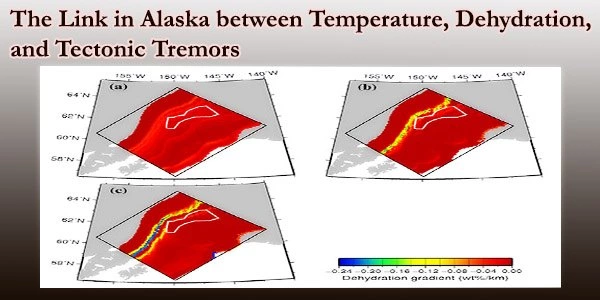The mechanism underlying low-frequency tectonic tremors has been clarified by a research team at Kobe University; this work will improve forecasts for megathrust earthquakes in the future.
The Yakutat terrane, a subducting oceanic plateau, is another feature of the Alaska subduction zone in addition to the Pacific plate. Only in the subducted Yakutat terrane region have slow earthquakes known as low-frequency tectonic tremors been seen. However, the mechanism by which these events occur is not well understood.
In order to identify the mechanism causing these low-frequency tremors, scientists from Kobe University ran a 3D numerical thermomechanical simulation of thermal convection in the Alaska subduction zone.
The researchers computed the water content distribution and compared the results in the region where the tremors occur based on the 3D thermal structure generated from the simulation and the indicators of hydrous minerals included in the slab.
The results showed that the marine sediment layers and ocean crust in the earthquake region were severely dehydrated.
The marine sediment layers and ocean crust are thicker in the Yakutat terrane, which means that the level of dehydration is higher there than in the western adjacent Pacific plate (where tectonic tremors don’t occur), according to the researchers, who theorize is the reason the tremors only occur there.
The Kobe University research group consisted of 2nd year Master’s student IWAMOTO Kaya (Department of Planetology, Graduate School of Science), Academic Researcher SUENAGA Nobuaki and Professor YOSHIDA Shoichi (both of the Research Center for Urban Safety and Security).
These results were published in the British online scientific journal ‘Scientific Reports’ (Nature Publishing Group) on April 14, 2022.
Main Points
- Understanding the mechanics of low-frequency tremors is essential to comprehending plate subduction. This is anticipated to shed light on the origin of shallower megathrust earthquakes.
- In this study, the research team built a 3D thermomechanical model of the Alaska subduction zone and determined the maximum water content and degree of dehydration of the subducting plate.
- The area where low-frequency earthquakes take place has the highest degrees of dehydration from the subducting plate’s marine sediment layers and ocean crust. As a result, it is hypothesized that the water ejected from the subducted plate helps to cause these tectonic shocks.
Research Background
An oceanic plateau called the Yakutat terrane is subducting in the Alaska subduction zone. Low-frequency tectonic tremors occur at this subducting plateau. The deeper depth and proximity of the region where slow earthquakes (such as low-frequency tectonic tremors) occur to the region where megathrust earthquakes occur shows a link between the two.
Therefore, understanding the process underlying the occurrence of different earthquake events in subduction zones requires the disclosure of low-frequency tectonic tremors.
A 3D thermomechanical model of the Alaska subduction zone was built by this study team so they could examine the temperature and dehydration levels in the vicinity of the low-frequency tremors.
Research Methodology
The researchers performed a 3D numerical thermomechanical simulation in accordance with the subduction of the Yakutat terrane and Pacific plate in the Alaska subduction zone. It is believed that the hydrous minerals in the slab are transported into the deep, high-temperature, and high-pressure regions when the Pacific plate subducts and that these conditions lead to a dehydration reaction in which water is ejected from the hydrous minerals.
The dehydration levels of the hydrous minerals in the slab were calculated by the researchers based on the 3D thermal structure that was acquired from the numerical simulation. From these findings, it was deduced that a significant volume of water is ejected in the area where low-frequency tremors occur as a result of the high temperature and high-pressure conditions that result in the dehydration degradation reactions. It is thought that low-frequency earthquakes don’t occur in the Pacific plate because it has thin layers and therefore experiences little dehydration.
On the other hand, the Yakutat terrane’s ocean crust and marine sediment layers are comparatively thicker, meaning that it experiences high levels of dehydration. The researchers concluded that this is why low-frequency tectonic tremors only occur in the Yakutat terrane.
Further Research
In 1964, a megathrust earthquake occurred in Alaska. This is the second-most violent earthquake ever recorded in human history and the largest earthquake to ever occur in the Alaska subduction zone. The low-frequency tectonic tremors that were the focus of this study take place near the downdip of the plate contact, not far from the epicenter of the earthquake that occurred in 1964.
Next, the research group will continue to make thermomechanical models of various subduction zones to search for universal and regional characteristics of the causal mechanisms behind undersea megathrust earthquakes and slow earthquakes.
This research will contribute towards improving understanding of how earthquakes occur and our ability to predict future megathrust earthquakes.
Glossary –
- Low-frequency tectonic tremors: A seismic event that is characterized by lower-frequency seismic waves than a regular earthquake.
- Slow earthquake: A phenomenon where a fault slips at a slower speed than in a regular earthquake.
- Oceanic plateau: A comparatively flat area of the seabed.
- Slab: refers to the subducted plate.
- Hydrous mineral: Minerals that contain OH groups in their crystal structure.
- Dehydration degradation reaction: As the plate subducts, the resulting temperature and pressure causes phase transformations of hydrous minerals and they expel water.





